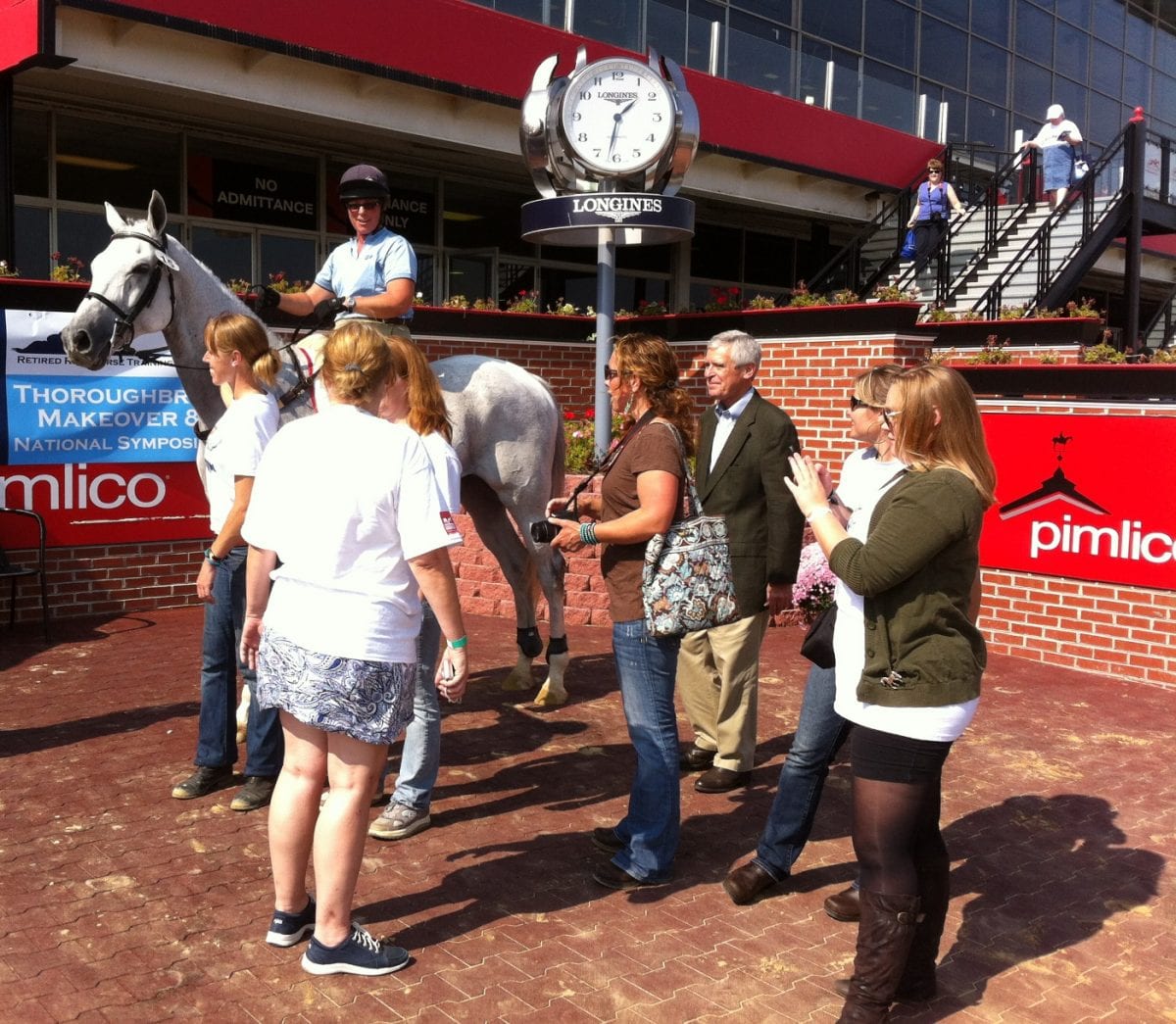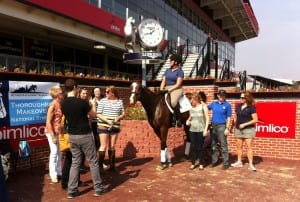by Teresa Genaro
A couple of dozen Thoroughbreds took to the track at Pimlico last weekend, but not to run in a race. There was no starting gate, no betting, and no jockeys, but more than 600 people bought tickets to see what the horses could do beyond competing in a horse race.
[boxify cols_use =”2″ cols =”5″ position =”left” order =”none” box_spacing =”5″ padding =”5″ border_width =”2″ border_color =”blue” border_style =”solid” height =”85″ width =”50″ ]To hear a 45-second clip of Georganne Hale discussing how the Makeover came to Pimlico…[sc_embed_player fileurl=”https://www.theracingbiz.com/wp-content/uploads/2013/10/ghaleintvwsnippet.mp3″][/boxify]The Retired Racehorse Training Project took over the Baltimore track for the two-day Thoroughbred Makeover and National Symposium, bringing together ex-racehorses and their new trainers; rescue, retirement, and retraining programs; and racing industry organizations to share ideas about how best to develop and sustain Thoroughbred aftercare programs.Trainers offered advice on working with off-track Thoroughbreds; veterinarians identified common physical issues in OTTBs; and horses performed in a variety of disciplines, including polo, cattle cutting, dressage, and cross country.
Earlier this year, Pimlico hosted the Totally Thoroughbred Horse Show, part of the Thoroughbred Alliance Show Series, at which RRTP president Steuart Pittman, Jr. served as a judge.
“He was looking for a perfect place to have this event,” said Georganne Hale, director of racing and racing secretary at the Maryland Jockey Club, “and once he saw the horse show, he realized, ‘Wow—we could put a lot of people in here.’
“He came to us and asked if he could have his event here, and he got it done.”
In May, RRTP selected 26 trainers from 142 applicants to participate in the Thoroughbred Makeover; those trainers chose horses who hadn’t yet received any post-race training and blogged about the experience of introducing a horse to a second career.
“I think the story here is that all racehorses have the prospect of doing something else,” said RRTP vice president Carolyn Karlson. “Horses are like people: they’ve got different strengths, and I think the beauty of this weekend is that we’re able to showcase 10 different disciplines.”
The participants came from widely varying backgrounds. Stud Muffin, a multiple stakes winner, retired at age eight with earnings of over $670,000. Bold Vindication raced until he was seven, but notched only three wins from 62 starts. Three-year-old Armelda made only two starts before retiring with earnings of $620.
What they all have in common is that they were retired sound enough to be retrained, a message that Hale thinks was conveyed to the people who make the decisions about retiring their horses.
“I think this has showed a lot of owners that their horses can do something else,” she said. “It’s educational for everybody here.”
And education, said RRTP’s Karlson, is what the organization is all about.
“We don’t go get the horses and retrain them,” she explained. “Our mission is educational, but it’s also collaborative.
“The racing industry has a lot of fragments, and the communication that exists between those fragments isn’t always perfect. One of the things we wanted to do was to bring people together. Events like this and publicity like this means that people who aren’t here see it, too, that’s what gets the conversation going.”
And it appears that the conversation started last weekend will keep going. Maryland Jockey Club president Tom Chuckas attended the event on Saturday and, according to Hale, is already talking about hosting the event next year.
“We were thrilled to have him here,” said Karlson. “He said, ‘We endorse you, we support you, and we’d love to have you back next year because this is what racing needs.”









I love to see two of my friends involved in this – Carolyn for helping put the event together and Teresa for reporting on it. I hope to be able to attend and/or be involved with the project next year!
It was great to see the cooperation and camaraderie that made this event possible and a great success too. Pimlico let Pittman have the venue free of charge and also provided security and amenities. Alex Brown tweeted periodically on Saturday showing panoramic views of the crowd and letting people know that over the weekend 750 people actually attended (ticket holders and others) Steuart passed along the goodwill by extending the number of OTTBs who could participate by just a few so that other OTTB trainers/owners could share the stories of their very special horses. See Susan Salk’s OTTB Blog today to learn about one: Prodigioso! http://wp.me/p11VOo-3Xn
See what some concerted cooperation will do? Looking forward to next year already & hopefully other tracks will ASK for events such as this to be held at their venues too.
I was a trainer at RRTP, it was great to teach people that race horses are great to do anything. I work out of mountaineer park and been trying to tell them to see the light of being positive rather sticking their heads in the track only sand. They have a great infield that is good for polo, shows anything, to help find new carreers for TB horses.
We love my 12 yr old daughters OTTB “Crusader” and our good friend Lara Knight who also took part in the RTP at Pimlico aboard Robs Rock “Ari”. She was the crazy gal doing handstands on horseback !!! Go team Lara Knight Eventing!!!
I’m out of the active horse racing circles now but I continue to hope racetrack honchos will awaken from their slumbers. A long time investment, creating a true interest among the young is the only savior of this great sport. I’ve suggested to Santa Anita for several years. Dedicate one barn on the backside and staff it with retired horsemen. It would be a haven where young people could come inside the ropes of our secured backstretch to get “hands on” experiences of working with the horse. Before I go one furlong further, I must state I know all about the “liability concerns” and this is something we must bite the bullet on. If it costs, so be it, because the residuals down the line outweigh the risks. In addition, I have suggested a racetrack facility like Santa Anita also purchase a small off property barn where they could offer the same “hands on” day to day experiences of working with the thoroughbred. Forget these T-shirt promos and get real. Promote the young, with the long range goal of turning around a customer base that has turned into a legion of us who are on Social Security. I wrote about this issue years ago when I used to frequent the racebooks in Las Vegas. I looked around the room and it was dominated by “greybeards.” Yes, Virginia, there is an answer for our falling numbers but horse racing does not(at least to this date) want to wait that long to get bang for their investment buck. I can tell you from experience I’ve personally seen the lasting impressions left on young people when we give them a “hands on” opportunity to work around and take care of the horse. They could be future grooms, trainers, or merely someone who gets a taste of our wonderful sport from up close. I keep praying racetrack execs will address the age of their customer base. Nobody, at least that I know of, is listening.
Sorry for the long, long delay in responding, but it’s great to see the positive responses to the event. While the issue of Thoroughbred retirement still presents a lot of challenging problems that aren’t easy to solve, it’s good to see what feels like relatively major progress in a relatively short amount of time.
Warren: I worked for some time on an education proposal that would do many of the things you suggested. Got a lot of interest in it, but logistical and financial challenges have it on the back burner. Still hoping to get it going one of these days.